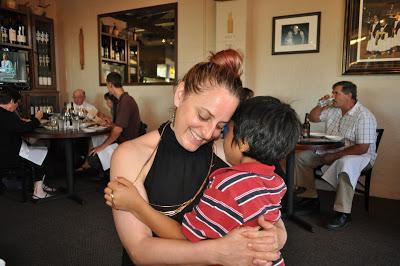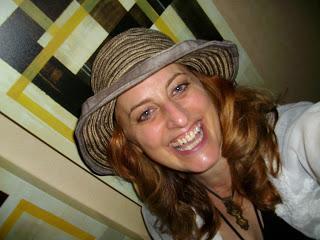 The doctor sucks in his breath, folds his hands over his chest. He leans back in his chair and tells me that my eggs are too old, that IVF will probably fail.
The doctor sucks in his breath, folds his hands over his chest. He leans back in his chair and tells me that my eggs are too old, that IVF will probably fail.“I’d like to try anyway,” I say.
To my surprise, he flat out refuses. Perhaps this famous Tokyo fertility clinic doesn’t want to add any failures to their high success rate. In America, I think, they’d keep taking your money until you ran out. But here in Tokyo, the doctor says no. And no means no.
“Don’t waste your money, time, or energy,” he says, not unkindly.
“What are her options?” my Japanese husband asks anyway, catching my dejected look.
“She could always try a donor egg,” the doctor says, shuffling papers on his desk and glancing up at the clock.
There’s just one problem. Donor eggs are illegal in Japan. After ten years of trying for a child, I know I’m at the end of the road. But I’m not someone who gives up easily. My husband reminds me that walking away from the fight is sometimes a sign of strength, not weakness. The Japanese have a term for it: the nobility of failure.
You hold your head high as you walk away from the fight. Throwing down your sword is a way to take back your own power. When one has tried one’s best, “failure” is noble, dignified. I also understand that “failure” is sometimes just a prelude to success. So I hold up my head, try to be dignified. I try to embody the samurai spirit. I tell my husband: Just keep me away from anything sharp.Letting Go
I get out my yoga mat and I practice. I breathe out the frustration, the disappointment, the pain. I breathe in the dream of our child, our beautiful child. I wonder where he or she is. I had faith that I could conceive naturally, but that didn’t happen. I still feel that my child is out there. I just have to keep searching until I find him.
As in many days over the years, I ask myself questions many mothers never consider. Why do I want to be a mother, anyway? I meditate on the answer. I want to experience another kind of love, something beyond what I know or can even imagine. Mother love. I want to experience this kind of earth-shattering, unconditional love of a mother for her child. The oneness.
But it wasn’t as if I’d put my life on hold. I’d written some books, opened up a yoga studio in a foreign country. Maybe it was because I’d opened a yoga studio that I’d failed to conceive. If I’d had a child, I’d certainly have been too busy to care for the students who depended on me there. We’d created a community, a family together. We mothered each other.
Perhaps my body was protecting itself. Giving birth might have been too risky for me, with my very slow heart rate, which I’d had since birth. I, or the child, might have died in childbirth. The doctor said these things. My mind chatters on and on. I have to stop these endless wanderings. So I sit and close my eyes, focus on my breath. I practice Tonglen, the Tibetan Buddhist practice of “giving and taking.”
Tonglen is one of the best methods I know of cracking open the heart. To help get me outside my own “story” and “suffering,” I practice taking away someone else’s pain. I breathe it in and send them the wish for happiness and peace.
In the meditation, I picture people I know—my mother, father, friends—and see them in pain. With each breath, I imagine taking the pain into my heart, transforming it with love in an explosion of light, destroying it forever. Then I send them the wish for happiness and freedom, and shower them with anything that will make them happy. I make an offering of this wish—sending them their favorite foods, their loved ones, a beautiful sunset. Whatever they love.
Once I can hold my concentration, the meditation is not so difficult. It’s a joy to help those I love and care for. But send those who’ve hurt us the wish for happiness? That’s a bit more challenging. Still, I persevere.
Next, I picture someone I barely know—someone who has served me in a cafe, or my local bus driver. Can we care about someone we don’t know at all, barely even notice in our daily lives? Can we take on their pain and suffering, try to take it away? It’s a powerful practice.
Lastly, I practice taking in all the pain in the world, and transforming it into happiness. Little by little, I find that my own life becomes happier and somehow free. In my meditations and in my yoga practice, I try to listen within. Soldiering On
Then I go online and research adoption in Japan. I discover that the adoption of adults is common practice for financial or business reasons, but adoption of children is rare. The number of waiting children is small compared to other countries. Foreigners are outsiders, so the chances of a successful placement seem slim, even with a Japanese partner. People do manage to adopt here, though. In 2004, family courts recognized 322 adoptions of children under the age of six, and 998 adoptions of children over six.
That’s 1,320 adoptions, with less than half of those between children and parents who have no blood connection. In other words, most adoptions are still within the family. In the U.S., there are approximately 127,000 annual adoptions. 1.7 million households have an adopted child.
We decide to apply, though the odds are daunting. To add to the challenge, of course, everything must be discussed in Japanese. I appreciate that Shogo is a translator and that he has the patience of a saint. I also appreciate that in some ways I am probably only going to catch half of what is happening. So I won’t know how much I am up against, and that’s a definite plus.
My yoga has taught me the value of process, of being in the moment. We just take each step as it comes, breath by breath. At forty-four and forty-eight, our ages make us low priority. But my age also makes me more determined. If I’m lucky, I have around ten thousand days left to live. How do I want to spend them? Though I love Shogo deeply, I want my world to be bigger than just us two. Besides, we have nothing to lose.
When our application is approved, I am overjoyed, and surprised. Could our dream finally be coming true? We wait for a placement, and I practice and practice. If it is meant to be, it will happen.
At the studio, I have students do Sun Salutations blindfolded so they don’t look outward. So they can look, and listen, to the teacher within. It’s unnerving, and powerful. How much of what we do is dictated by what we’re told, or what’s expected of us, or what we think others will approve of?
I put the blindfold on myself. I forge onward, keeping my ears tuned to that faint inner voice that gets louder and louder in the listening. I keep my ears open for the voice of my child. Trusting. Letting go. Trusting. Hoping. Letting go. I watch the thoughts come and go. I do my practice throughout. I remember the words Krishna says to Arjuna in the Bhagavad Gita:
That one is dear to me who runs not after the pleasant or away from the painful, grieves not, lusts not, but lets things come and go as they happen.
And then, six months later, my husband and I get the call we’ve been waiting for. A placement. A two-year-old boy.
This time, when I sit down in meditation, instead of waiting to hear his voice, I speak directly to him.
“Hold on,” I say. “We’re coming.”
The above is excerpted, in slightly different form, from her forthcoming memoir, Here Comes the Sun: A Journey to Adoption in 8 Chakras about Lowitz’s journey to motherhood over two oceans, two decades, and two thousand yoga poses. See Stone Bridge Press for further information.
Leza's Young Adult novel in verse about Japan's March 11, 2011 earthquake and tsunami, Up from the Sea, will be published by Crown Books for Young Readers (Penguin Random House) in 2016. Please visit: www.lezalowitz.com.
Subscribe to Yoga for Healthy Aging by Email ° Follow Yoga for Healthy Aging on Facebook ° Join this site with Google Friend Connect
